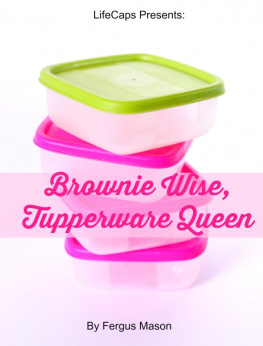LifeCapsPresents:
Brownie Wise,Tupperware Queen:
A Biography
By FergusMason

2011 by Golgotha Press,Inc./LifeCaps
Published at SmashWords
www.bookcaps.com
About LifeCaps
LifeCaps isan imprint of BookCaps Study Guides. With each book, a lesserknown or sometimes forgotten life is recapped. We publish a widearray of topics (from baseball and music to literature andphilosophy), so check our growing catalogue regularly( www.bookcaps.com ) to seeour newest books.
Introduction
Marketing. Its ubiquitous and getting more so every year. Were constantly bombardedwith sales messages, from ads on the subway, through internetpopups and the constant barrage of commercials on TV. A lot ofpeople have made fortunes selling ways to keep spam out of youremail inbox, and a huge advantage of DVRs is they let you recordyour favorite TV shows then play them back without thehigh-pressure sales segments. Some of us hate marketing more thanothers, but pretty much everyone wishes they were exposed to lessof it. Politicians and academics have boosted their careersstudying, or complaining about, the influence of marketing onlifestyles and health. Marketing is a nuisance.
But at the same time its also valuable. Since the late19 th century the choice of consumer goodshas been expanding, especially since the US industrial boom thatfollowed the Second World War, and this growth is showing no signsof slowing down. In fact if anything its increasing. This meanswere all faced with constant decisions about what to buy whetherwe should be buying most of it at all is a different issue andgood marketing can help us make those decisions. A lot of the timeits heavily slanted but it can be informative; its fair to saywere better having some of it than none at all. The tricky bit isfinding the right balance, and it would also be nice if marketinggot delivered in a way that didnt annoy people quite somuch.
That lastfactor, making advertising more acceptable to its target audience,has driven a lot of innovation and attracted some very creativepeople to the industry. There have been failures, of course, andunsolicited commercial email is probably the worst, but a fewsuccesses as well. Viral videos are a recent one. These clips,often with a subversive air of fun, nudge consumers towards aparticular product - but to achieve wide distribution they rely onthe fact most people like them. Thats economical for theadvertiser because instead of paying for expensive air time orspace they get the target audience to do the work for them, but italso reduces the irritation factor. People arent being bombardedwith junk by faceless corporations. Theyre being sent a funnyvideo by a friend.
Viralmarketing is a child of the digital age but the basic principlebehind it making marketing fun is a lot older. It might go allthe way back to the Roman arenas, where gladiators advertisedbrands of olive oil to the crowd as they buffed their muscles withit, but it certainly existed by the post-WWII period and it tooksuburban America by storm in the early 1950s. How did thathappen?
In 1950, asuccessful saleswoman living in Florida decided to find a fun newway to market an unexciting product: reusable food containers. Shealready had plenty of experience selling household goods but nowshe wanted to try something different, and she was after a quirky,lively way to sell things. The solution she chose was being used tosell brushes in the USA by the late 1930s, but now its spreadthroughout the entire world and been adapted to a wide range ofdifferent products. Mostly thats because it was made famous byBrownie Wise and Tupperware. Yes, Tupperware isnt very exciting,but what could be more fun than a party?
Chapter 1
In the rural USA in 1913 , most women didnt have jobs. Thats not to say theydidnt work hard housekeeping was a far bigger task withouttodays labor-saving appliances, and women living on a farm woulddo their share when the crops had to come in but not many of themgot up every morning, fixed breakfast then went out to an office orfactory. It was a bit different in towns though, even a small onelike Buford, Georgia. Some women did go out to work, often ingarment making or similar industries. Rosabelle Stroud Humphrey wasone of them. Her husband Jerome was a plumber, and would have madea good living at that time indoor plumbing was becoming common,and there was plenty of work for someone who could install it butRosabelle had an independent streak and wanted her own income aswell. She worked in a local hat factory and, even in an era whenwomen were excluded from politics in most states, was an activistfor employees rights. That independent streak would be passed onto her only child.
Rosabelle s daughterwas born in Buford on May 25, 1913. Today, many babies have theirname chosen for them long before theyre born but in the early20 th century it was different. In factthe Humphreys didnt know the babys gender until she was born.When Rosabelle held the infant, the first thing she noticed was herbig brown eyes, and that was enough to decide her name. Lets callher Brownie! she exclaimed, and so they did.
Even when women did have a job in the early 20 th century theyusually quit when they started a family and became stay at homemothers. Rosabelle had no intention of doing that; as soon as shecould, she went back to work. Baby Brownie was looked after by herextended family during the day, a common practice at the time. Thatfamily network became even more important when she was just acouple of years old and the Humphreys divorced. Now Rosabelle wasthe only breadwinner and her job mattered more thanever.
Not long after her divorce Rosabelle became more active inthe local chapter of the Hat Makers Union. That doesnt sound likea big deal nowadays but until the 1950s almost every man and womanin the USA owned at least one hat, and it was a major industryemploying hundreds of thousands of workers. Most of them were womenand they often suffered discrimination or even sexual harassment- at work, and just to add insult to injury they were almost alwayspaid less than men. The union was determined to get a better dealfor its members and Rosabelle was one of its most vocalcampaigners. She soon worked her way up to become an organizer, butthat made it hard for her to bring up herdaughter.
Being aunion organizer meant a lot of travel, and at a time when strikesand pickets were often broken by hired gangs of armed men, it couldbe dangerous, too. That didnt deter Rosabelle, but she had to findsomeone who could bring up Brownie for her. That person was herolder sister. Pearl worked near Atlanta as a dressmaker and Browniespent most of her childhood there, surrounded by cousins. It wasthat environment that shaped most of her character, although shedid inherit Rosabelles determination and self-reliance.
Going through school in Atlanta Brownie turned out to be anintelligent student , but nota very motivated one. She could do the work easily enough but shewasnt really interested in it. Instead she preferred reading aboutfashion, and that soon developed into a fondness for wearing it.She liked to primp, according to her cousins dressing up andlooking glamorous was what made her happy. As a teenager she alsotook an interest in dating. By this time it was already obvious shehad a strong personality and preferred to get her own way, butunlike her combative mother she used more subtle ways to do it. IfBrownie wanted you to do something she would turn on the charm andpersuade you it was a good idea, instead of being pushy andaggressive.
In 1927, at the endof eighth grade, Brownie left school and started looking for acareer. At first she reunited with her mother and began travelingwith her, even giving speeches at union meetings. That was unusual:a 14-year-old girl talking to groups of adult workers andactivists. It would certainly have given Brownie an early andintense exposure to the problems faced by working women at thetime, and perhaps it motivated her to achieve more independence inher own career. Luckily for her there was help available to dothat.
Next page








